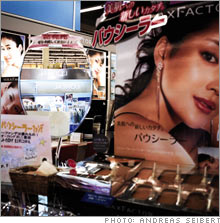Why Wal-Mart can't find happiness in JapanThe world's largest retailer has spent more than $1 billion in Japan, but its Seiyu stores are struggling to overcome consumer apathy and employee distrust. Will it stay the course? Fortune's William J. Holstein reports.(Fortune Magazine) -- The Seiyu superstore 90 minutes north of downtown Tokyo has all the hallmarks of true cultural fusion - a cross between the bare-fisted American-style cost-consciousness of Wal-Mart and the distinctly Japanese need for delicate mustard-green sprouts and whole fish displayed on juniper leaves and blocks of dry ice. Wal-Mart, which took control of Seiyu in 2005, built the store next to the train station at Hitachino-Ushiku, a "bed town" from which salarymen commute to Tokyo. It is a critical part of the U.S. retailer's attempt to achieve profitability in the Japanese market.
There's parking for 1,000 cars outside the 145,000-square-foot, two-level store. Inside, the aisles are Wal-Mart wide and brightly lit. Employees use handheld scanners to check inventory and connect wirelessly to the store's Wal-Mart computers. Manager Isao Saito points with pride to his deli counter, walk-in refrigerated beer depot, and huge display of Florida grapefruit. His goal, he says, is to be ichiban, or No. 1, among nearly 400 Seiyu stores in Japan. But one store does not a success story make. The reality is that Wal-Mart (Charts, Fortune 500) is battling to survive in Japan, the world's second-largest economy, with a population of 127 million and one of the highest per capita incomes in the world. It's a battle that Wal-Mart cannot afford to lose because of the imperative to avoid overreliance on a U.S. market that may be reaching saturation. Having pulled out of Germany and South Korea after faring poorly in those markets, the giant retailer is doing well in China and Mexico under its own brand and reasonably well in Britain under the ASDA name. But if Wal-Mart walks away from Japan, where it has invested more than $1 billion in a 51 percent stake in Seiyu and in bringing in its own distribution and computer systems, the company's hopes of creating a credible international strategy will take a serious blow. "Wal-Mart, being a company that would like to grow around the world, cannot just ignore a market of this particular size," says Ed Kolodzieski, Wal-Mart's top executive in Japan. Wal-Mart's foray into Japan is under pressure on two fronts, one Japanese and the other American. First, even before it took full control, Wal-Mart persuaded Seiyu's management in 2004 to dismiss 25 percent of headquarters staff, including 1,500 employees and managers. That kind of mass firing happens rarely in Japan, which places a premium on social harmony. And when the firing is done at the behest of foreigners, it takes on added negative connotations. Partly as a result, the fired employees and current ones as well have created a climate of resistance. They are frequently quoted in Japanese media complaining about Wal-Mart's efforts to instill an American operating model in Japan. The company says it is being flexible, but the carping persists: Wal-Mart is moving too aggressively to cut out distribution middlemen; it is making life difficult for managers by mandating that stores remain open for 24 hours; it is introducing products from China and elsewhere that don't meet Japanese tastes or standards of quality. "Seiyu became a completely different store after it came under Wal-Mart management," the magazine Nikkei Business quoted one store manager as saying. "National-brand food product prices have definitely come down, but high-quality merchandise has disappeared from the shelves, and customers have left." The heart of the problem, the naysayers argue, is that Wal-Mart's model of "always low prices" may work in developing, under-retailed markets such as China and Mexico, but it doesn't work in a country like Japan, where consumers are willing to pay top prices for exclusive goods of the highest quality. "They need to completely change their strategy, but it's too late," says Tadayuki Suzuki, who worked at Seiyu for 20 years, is a former Merrill Lynch retail analyst, and now runs the retail consultancy Clio Research. "They are doing it totally wrong. They should pull out of the country and focus on China." Japanese competitors such as Aeon and Seven & I Holdings, owner of 7-Eleven convenience stores, may be fanning the flames of discontent because they hope to sweep in and acquire Seiyu at a steep discount. Partly because Japan's aging population has started to decline, the retail market has too many stores. A major consolidation of retailers is underway, as evidenced by Aeon's recent purchase of eight Japanese stores from French retailer Carrefour. It also edged out Wal-Mart to take control of struggling supermarket chain Daiei. A second pressure point for Wal-Mart's Japanese aspirations is its shareholders in the U.S., eager to see Wal-Mart's long-ailing stock find new legs. Those dissident shareholders, concerned about costs in Japan, have mounted a campaign in the U.S. to have the retailer pull the plug. Nor are Wall Street analysts cheering Wal-Mart on. "Wal-Mart's longer-term success [is] more likely in China than Japan," Morgan Stanley said in a recent report. It added that there is "little reason to think Wal-Mart is the winning consolidator, unless it can really leverage know-how. Its investment in Seiyu could be another $1-billion-plus mistake." Wal-Mart started exploring Japan in 2002 and took a minority stake in the retailer late that year. A team of Wal-Mart advisors moved to Japan and wielded some influence over Japanese management. (Walton family member Greg Penner, a son-in-law of Rob Walton, served as CFO of Wal-Mart Japan and still sits on Seiyu's board.) The decision to become a majority owner came in December 2005, but it wasn't until a year later that chairman Masao Kiuchi left the company. So only in recent months has Wal-Mart found itself in a position of full control. |
Sponsors
|



